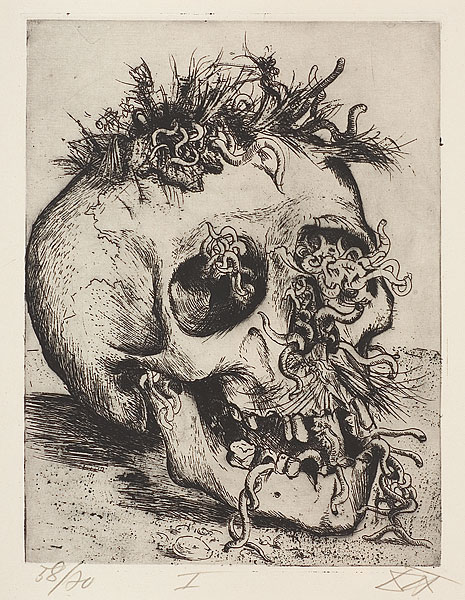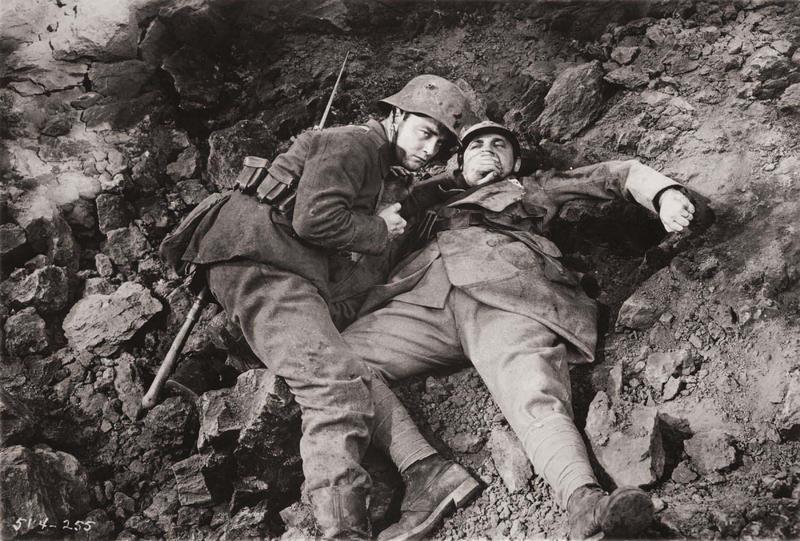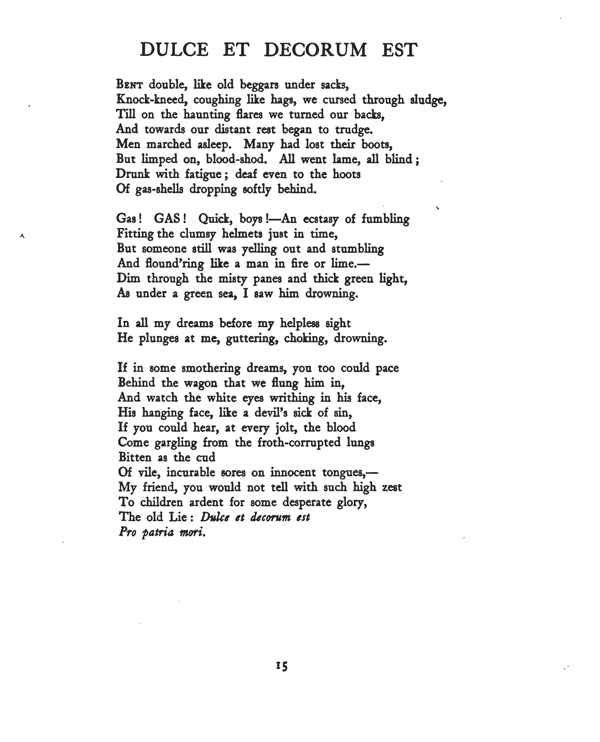[Created: 20 July, 2014: Updated: 20 July, 2014]
This is a summary of the material on WW1 which I have online. I will be adding more during the centenary years.
[Otto Dix, “Skull” (Schädel) Der Krieg (1924)]
War Art:
- “Otto Dix and the First World War (1924)” – Dix was a German artist who served on the western front and worked throughout the Weimar Republic documenting his experiences in some very disturbing works, such as dead and decomposing soldiers in the trenches and Weimar prostitutes. I have a survey of his life and work, a sample of his drawings for Der Krieg (The War) (1924) from my old blog, and the full collection of 50 drawings.
- the illustrated The ANZAC Book (1916) PDF 15.3 MB which contains drawings, poems and articles written by Australian and New Zealand troops during their disastrous invasion of Gallipoli, Turkey in 1915. The book was compiled in late November in order to raise money for the war effort but with the additional, unstated goal of telling the world about how the ANZACs had coped in battle. It contains material by both officers and men and some of the material expresses frustration and even anger at the things that the enlisted men had to endure.I discuss these poems and drawings in several postings at my old blog – Part I: Coloured Plates, Part II: Two ANZAC Alphabets, Part III: An ANZAC Alphabet (Henderson), Part IV: Another Attempt at an ANZAC Alphabet (Ubique).
- an illustrated essay on the phrase from one of Horace’s Odes “it is sweet and fitting to die for the fatherland” called “Abel Gance, “J’Accuse” (I Accuse) (1938) and Remembrance Day 11.11.11″. The essay also contains several links to film clips. Gance used as extras actual French soldiers on leave during WW1. The film ends with some of the most unforgettable images in cinematic history – all the dead from all the wars rise up from their graves to seek revenge for what the politicians and generals did to them.
- a lecture I have given on “Propaganda and Obedience to the State” which contains many examples from WW1 – slide show from the lecture.
- a selection of graphic photos from Ernst Friedrich’s Krieg dem Kriege! Guerre a la Guerre! War against War! Oorlog aan den Oorlog! (1924). His strategy was to shock people into realising the horror of war by showing pictures of dead and disfigured soldiers. He also wrote bitter and sarcastic captions to accompany the photos. Friedrich founded the Anti-War Museum in Berlin in 1923 which lasted until 1933, when very appropriately, Nazi thugs looted the building forcing it to close.
[“The Ideal (Soldier) and the Real”, The ANZAC Book (1916)]
War Films:
[Paul Baumer kills a French soldier in a shell hole – AQWF (1930)]
- See the main collection of film guides I wrote for a course I once gave on “war and film”. I showed a total of 84 films over a period of several years. In Part A – From the Bible to the Boer War (1901) I showed 34 films, and in Part B – The 20th Century and Beyond I showed 50 films. Here are some of my favourites. I showed 10 films about WW1 for which I have the following 8 guides:
- G.W. Pabst, Westfront 1918 (Comrades of 1918) (1930)
- Lewis Milestone, All Quiet on the Western Front (1930) (Restored Version 1987)
- Jean Renoir, The Great Illusion (La Grande Illusion)(1937)
- Stanley Kubrick, Paths of Glory (1957)
- David Lean, Lawrence of Arabia (1962)
- Joseph Losey, King & Country (1964)
- Peter Weir, Gallipoli (1981)
- Derek Jarman, War Requiem (1989)
Clips from some of the films:
- Abel Gance, J’Accuse (I Accuse) (1938) – Gance “Accuses” the warmongering State, the Military-industrial Complex, and the Citizens who support them: Clip 1, Clip 2, Clip 3.
- Lewis Milestone, All Quiet on the Western Front (1930) – the school teacher Kantorek urges Paul Bäumer’s class to enlist to serve the Fatherland and reminds them of Horace’s line “dolce et decorum est pro patria mori” (it is sweet and fitting to die for the fatherland). Clip.
- Derek Jarman, War Requiem (1989) – One could view Derek Jarman’s War Requiem as a “pop video” made for a piece of classical music or as a silent film with Benjamin Britten’s music as background. The film combines four things: the poetry of Wilfred Owen, the traditional Latin requiem mass for the dead (traditional expression of mourning), Benjamin Britten’s music and the images of war selected by Derek Jarman. It is loosely based on the life of the poet Wilfred Owen. Laurence Olivier appears as an old soldier in a nursing home and was one of his last film appearances before his death. Clip.
- Stanley Kubrick, Paths of Glory (1957) – “The Calculus of Death” – The General tells Colonel Dax how many casualties he expects the unit to suffer in taking the objective. The men are expendable for political reasons. Clip.
[Col. Dax learns from Gen. Broulard about the expected casualties – Paths of Glory (1957)]
The Politics and Economics of War and Peace:
[Analysis of the destructive effect of new rifles on human bones – Bloch, The Future of War (1899)]
- the great Austrian economist Ludwig von Mises served in the Austrian army in WW1 and after being injured he worked in government economic administration where he saw first hand the problems of economic planing and shortages in wartime. Soon after the defeat of Austria and the emergence of communist revolutions in Russia, Germany, and Austria he wrote Nation, State, and Economy (1919) and then his great anti-socialist book Die Gemeinwirtschaft: Untersuchungen über den Sozialismus (The Social Economy: Explorations of Socialism) (1st ed. 1922). See Ludwig von Mises, Nation, Staat und Wirtschaft: Beiträge zur Politik und Geschichte der Zeit (Wien, 1919) PDF 12.7 MB. The English translation of this can be found at the OLL as Nation, State, and Economy: Contributions to the Politics and History of Our Time (Liberty Fund, 2006).
- in 1914 the leading French free market journal was the venerable Journal des économistes (founded 1841). Yves Guyot succeeded Molinari as editor after he retired in 1909 (he then died in 1912 at the age of 92). Guyot wrote a monthly article on the political and economic causes of the war as it was happening between August 1914 and April 1915 from a free market perspective. He believed the war was a struggle between German militarism and statism on the one hand, and English free market liberalism on the other (he seems to have forgotten about the British Empire). These articles were expanded and published as a book which is available in French and English. See Yves Guyot, Les Causes et les conséquences de la Guerre (Paris, 1915) PDF 23MB and in English – Yves Guyot, The Causes and Consequences of the War. By Yves Guyot, Late French Minister of State. Principle Editor of the “Journal des Économistes.” (New York, 1916) PDF 8MB.
- Jean de Bloch (1836-1902) was a Polish born banker and railway financier who lived and worked in Russia. The quick Prussian defeat of France in 1870 led him to pursue a scientific study of what a modern war might look like in the near future. He realised what a catastrophe the next war would be both politically, economically, and militarily and wrote a 6 volume work in Russian outlining his theories (he was remarkably prescient on a number of issues – unlike most of the senior officer classes of Europe). A 1 vol. abridgement was published in English and a 4 vol. one in French. The Germans got the full 6 vol. treatment but ignored it. The graphs and statistical tables about the destructiveness of modern weaponry and his predicted death rates are especially interesting. What is particularly noteworthy is the way he combined detailed knowledge of advances in military technology with his understanding of economics as a banker. The English version is Jean de Bloch, The Future of War in its Technical, Economics, and Political Relations (Boston, 1903) PDF 8MB. I have created some extracts in HTML: “VI. Probable Losses in Future Wars” and “VII. Militarism and its Nemesis” [with data tables].
- Francis Hirst (1873-1953) was an English classical liberal author and book editor who was the editor of The Economist from 1907 to 1916. He wrote biographies of William Gladstone, Adam Smith, and John Morley and many books on economics. While editor of the Economist he published the first book devoted to the “political economy of war” which drew upon the ideas of Adam Smith and Frédéric Bastiat. See, Francis W. Hirst, The Political Economy of War (London and Toronto: J.M. Dent & Sons, 1915). PDF 13MB
[Estimated future costs of fighting a war – Bloch, The Future of War (1899)]
War Literature:
- the war poetry of Wilfred Owen (1893 – 4 November 1918) Poems by Wilred Owen (1921) PDF 436KB. A collection of his war poems was published by his friend and fellow poet Siegfried Sassoon in 1921. He talked a lot about the tragedy of war but the great tragedy for him was to be killed one week before the Armistice brought WW1 to an end. My favourites are “Parable of the Old Men and the Young”, based upon the biblical story of Abraham who is commanded by his god to kill his own son (like the elder statesmen of Europe ordering the young men of their day to die on the battle field), and “Dulce et Decorum est”, which is a line from one of Horace’s Odes which states that “it is sweet and fitting to die for the fatherland” – a sentiment which Owen correctly calls “the old lie”.








Pingback: David Hart on the (so-called) ‘Great War’